In terms of total time spent away on vacation, this 18 day trip to South Korea hasn’t been our longest: the honor for that goes to our Dec 2023 trip to the Chubu and Kanto regions of Japan: that trip was longer by 1.5 hrs! But on the other hand, we spent more time thattrip in the air getting to and returning home from Japan, so technically, this South Korea trip is still the longest if I considered the amount of time spent in the holidaying country LOL.
Jokes aside, 18 days is a fairly long stretch for a Singaporean family to be on vacation without having to make serious covering arrangements at work, so we’re again thankful for this opportunity to travel for a substantial bit of time. This final blog post is one that I do for every family trip where I try to take a step back and reflect about the trip as a whole experience.
The first thing that comes to mind is how South Korea has compared to Japan as a destination for a family holiday. To be honest, both countries share many similarities: culturally somewhat, the sights, and the type of public infrastructure that tourists like us make use of. One difference though has been the type of places we visited this trip. Japan in terms of landmass is several times larger than South Korea, and this simply provided a larger variety of sights. Perhaps it’s also an unintended consequence of our choices of places included in this itinerary. But we previously frequented a lot of natural and religious sites in Japan, while our trip to South Korea this time saw a larger proportion of modern man-made places. And what the Koreans have done in their cities is just incredible: including taking very long cable car rides across mudflats and islands, going up Busan X The Sky and seeing the city from more than 400 meters above, and the Dongdaemun Design Plaza.
Of all the places we visited, the DMZ tour for me was the most memorable one. As in, I’ve visited the war memorial in Hiroshima during my 2019 trip. But that site, solemn as it is, was finally representing something while horrific but also historical and thus past. The DMZ tour was visiting a hot-zone and we were looking into a country that is still technically at war with South Korea. There were plenty of uniformed personnel about, and our coach drove past camps with rows of parked army vehicles. The obvious and significant military presence of the zone made sure everyone on the tour knew that. And our tour guide operator quipped that if our tour bus driver wasn’t having a good day, he could easily veer off the road on the right and drive us all straight into the minefield LOL.
OK, the minefield joke aside, that we were driving past military vehicles isn’t too unlike Singapore. But we’re a country in peace-time, while South Korea is not, technically again. This created a sort of surreal oh-my-what-if-Kim Jong Un-does-something today anxiety about the DMZ trip that – a feeling I don’t think you can commonly find as a tourist elsewhere, not unless you’re in the habit of traveling to war zones! At the Dora Observatory where we were at looking across the border into the hermit kingdom, I was joking to the wife that if war was to break out that moment, the observatory would be likely the first target that the North Koreans would plummet to dust haha!
Unlike our trips to Japan too, we found ourselves doing far less planning for this South Korea trip. Sure, a good part of it was because we made reservations for five guided day trips where someone else got to do the planning. But that this was a much easier trip to plan for our DIY segments was also because of the transportation network options in the three cities we were in. And I believe South Korea has a secret sauce: their own apps for transportation and mapping. We were initially uncertain how well apps like Naver Map and Kakao Map and would work for us. After all, Google Maps has always worked well for our Japan vacations. But once we got past the initial hurdles of installing and setting up the Korean apps, we found that they actually worked very well in getting us to where we needed to. These navigation maps were updated with the current place data, and offered real-time travel information including train arrival times. In contrast, location data on Google Maps was clearly dated / incomplete for even large cities like Seoul. A good case in point is the Jung-gu area we were in on Day 17. Google Maps shows a pretty bare place in front of Unseo Station: but in reality, the street was already pretty built-up with numerous eateries, restaurants, cafes and such – and they don’t look like they were built in the last year.
We also found the subway network in Seoul much easier to understand too, compared to the likes to Tokyo or Osaka. Line signage was clear – and in our view lines were logically laid out. We never felt lost in Seoul Station: compared to the likes of Shinjuku that we still get lost in even after several visits.
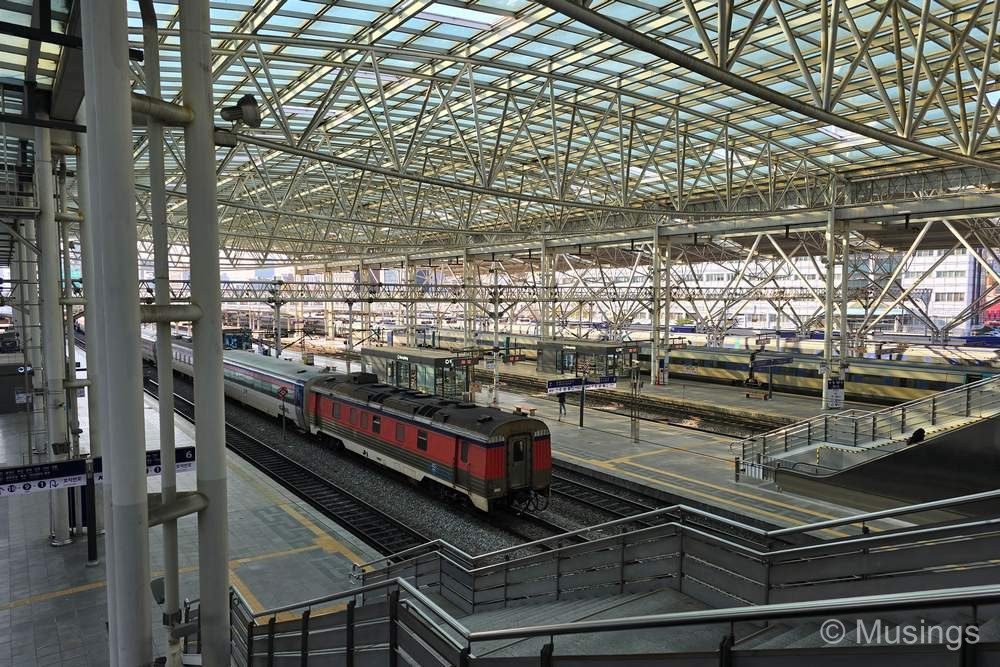
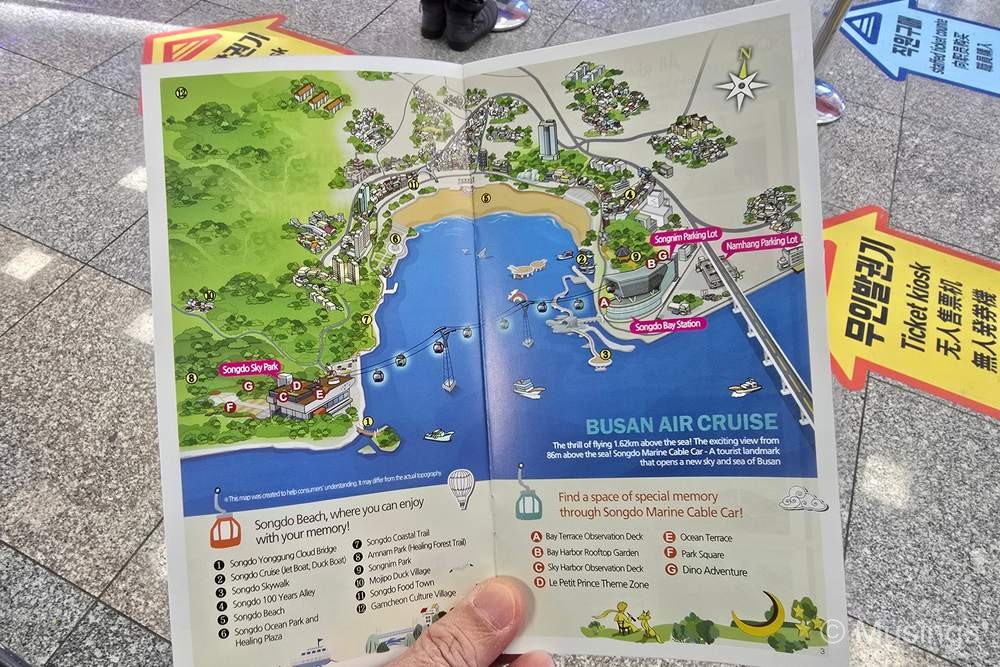
Another factor in making planning this trip easy was the low cost of taxi rides, coupled with how well Kakao-T, Korea’s taxi hailing app, worked. Simply put, we put our faith in Korea’s fleet of taxis to get us where we needed to be in each city. That most Korean taxi drivers didn’t speak English posed zero problems for us: we simply needed to install Kakao-T, put in our credit card details (much more convenient than trying to use cash, and note: many of our taxi drivers did not have change for 50,000 KRW bills), indicate the location we wanted to go to, specify the type of cab we wanted, then send the request. And frequently within just minutes, a taxi would take the booking and be on the way to pick us up with its current location and time of arrival showing up real time, and very accurately too. Best of all, rides were affordable: a 15 minute ride in Suncheon and Busan could cost us around 7,000 to 8,000 KRW only. In fact, the system worked so well that we ended up getting from place to place exclusively using taxis during the Busan and Suncheon segments of this trip.
Our Seoul segment was a different matter: aside from that half of our stay we were on day trips, traffic in Seoul was noticeably heavier and there were major junctions where traffic routinely slowed to a crawl. It simply made more sense for us to get where we need to within the metro area using the subway.
Korean drivers though are really one-kind. Our guide for our Alpaca World/Nami Island/Garden of Morning Calm day trip quipped that Korean vehicle drivers are crazy, and he wasn’t kidding! We lost count of the number of times where we witnessed clear and often outright dangerous violations of traffic rules. And these included speeding well past the speed limits (as in 110 km/h), reversing on main roads against prevailing traffic flow, making turns from non-designated turning lanes, and – worst of all – numerous instances of drivers proceeding to drive past pedestrian crossings even when the crossing lights were no longer in their favor. The situation isn’t as bad in Chinese cities like Shanghai of course where it always seemed to me that the drivers in those cities really do not care about pedestrians, even when they have the right of way. But one takeaway at least was that we could not take controlled pedestrian crossings for granted, and had to be extra careful every single time.
As a rule, we didn’t find language too much of a problem. Train and road signage were routinely also in English. That’s not to say though that English is widely spoken outside the touristy areas like Seoul Station, Myeongdong and Hongdae. But we made generous use of Google Translate to get by. And of course, that we were able to use Kakao-T made getting to and fro places in Busan and Suncheon super easy, since that app effectively removed any language barrier we might have had with the taxi drivers.
Like Japan, we found convenience and chain stores everywhere in South Korea, especially in the highly built-up cities like Busan and Seoul. Nice to CU, GS25 and 7-11 convenience stores were everywhere, including at the ground floors of apartment block in Busan and also hotel in Suncheon. And Koreans love their beverages! Aside from the couple of Gong Cha bubble tea outlets we walked past, there were also big cafe chains like Starbucks, Coffee Bean, Ediya Coffee, Mega Coffee, and Compose Coffee. We thought it was only a thing in Japan to have four Starbucks joints within 100 meters of each other: but boy, Seoul has that phenomenon too! Unlike Japan though, the prices of Joes at Starbucks and Coffee Bean in Korea were closer to Singapore i.e. pricey, so we ended up frequenting the local joints like Mega Coffee and Compose Coffee to feed the wife’s insatiable addiction to coffee. We found the prices of beverages at these chains much cheaper.
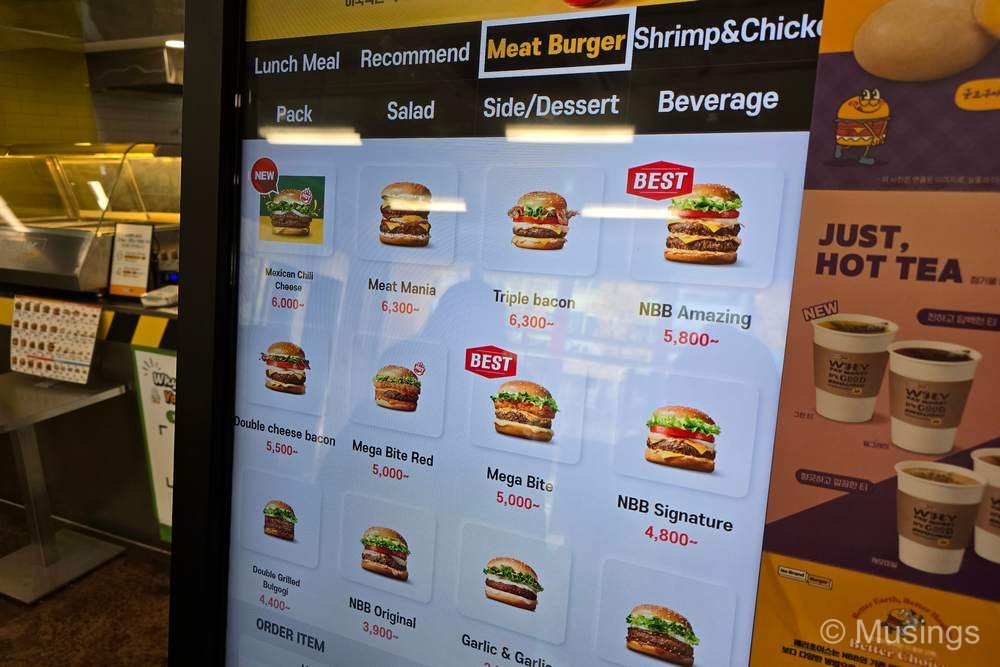
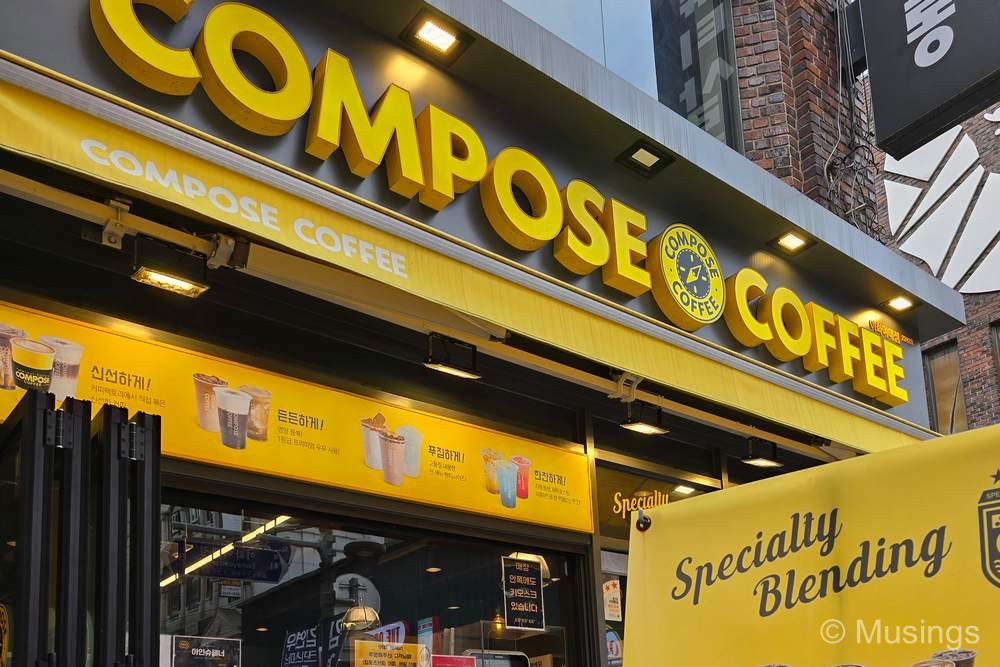
The weather was also a noticeable point of differentiation. We routinely can only travel from the end of the first week of December each year to Christmas. We were hoping to catch snowfall this trip, and were encouraged by the fact that Seoul had just experienced its heaviest snowfall in 100 years during that one day in late November. But instead, over the period we were in the country, we encountered only snowfall… twice. And these were the very gentle ones: on Day 09 early morning when we were departing Suncheon and making our way to Seoul, and on Day 15 late night. That’s it. Like the daughter said, we’d been scammed and we want our money back LOL. On the other hand, the ambient temperature was much colder than Japan. We were routinely experiencing subzero temperatures of -5 to -6 degree celsius everyday in Seoul. And on that one day we were at the DMZ, it was -12 degrees! For the most part, we were reasonably well-equipped to handle the cold, with each of us wearing between 3 to 4 clothing layers. But wind chill when it came was a different matter. All of us experienced different degrees of winter dry skin, and the large 530ml bottle of skin lotion we brought along was almost completely used up after 18 days.
Another thing I observed was that the South Koreans in service and F&B we interacted with were generally not as polite compared to the Japanese. By this, I don’t mean that they were rude: nothing like that. Rather, for the most part, we found them business-like, sometimes impatient, and occasionally curt. I get it: there are a lot of tourists visiting your country, and it can get overwhelming. But the Japanese we encountered were routinely extremely polite – to us tourist types, while it seemed to me that the Koreans didn’t always bother with niceties. We did run into super nice and warm Koreans though: e.g. the super chill taxi on Day 01 driver who didn’t speed and gave us commentary about the iconic landmarks in Busan when we were traveling back to our Airbnb from Gwangali Beach, the very helpful middle-age ladies manning the entrance gantries at Suncheon Bay National Garden, the super sweet restaurant auntie on Day 08 who took a liking to Peter and gave him a hug after lunch, and both of our Airbnb hosts. We only wish the wait staff, shop keepers, street stall vendors were all as nice.
Still, it finally didn’t bother us too much: as guests to the country, we continued to be on our best behavior, always greeting, smiling, saying thank-yous as best as we could and so on. But if you’re particular about reciprocity, then this particular aspect of local culture might annoy you a little.
We also observed that the Christians in South Korea are a pretty active lot: in that their street evangelism has little sugar-coating! The churches in Singapore have long gone past that whole “You will be damned to hell if you do not believe in Jesus” message, but we saw it in South Korea. There was that lady in front of Suncheon Station with a billboard that said “No Jesus = Hell”. In places like Myeongdong and outside Seoul Station, we frequently heard street soloists singing hymns. And at Seoul Plaza on Day 16 after we’d completed our ice-staking activity, there was a vehicle with loud hailers driving around blasting religious proclamations.
Of the 17 full days we had in South Korea, we spent 5 in Busan, 3 in Suncheon, 8 in Seoul, 1 in Incheon. We were able to meet our planned itinerary, excepting most noticeably snow-sledging in Hangang river park, visiting the Namsan Seoul Tower, and also our day trip to the Wondae-ri Birch Forest that was cancelled. Now that we’ve done one substantial trip to the country and we like it, we’d love to return! Except that now, there’s the dilemma of figuring out what else is there for us to do in the country. I reckon if we’re going to return to visit South Korea for holiday again in the near future, we could probably spend perhaps 4-5 days in Seoul for the daughter to replenish her stock of K-culture items, and also an equivalent amount of time in Jeju Island that we skipped this trip. And then, we’d have to figure out another substantial 8-9 day segment!
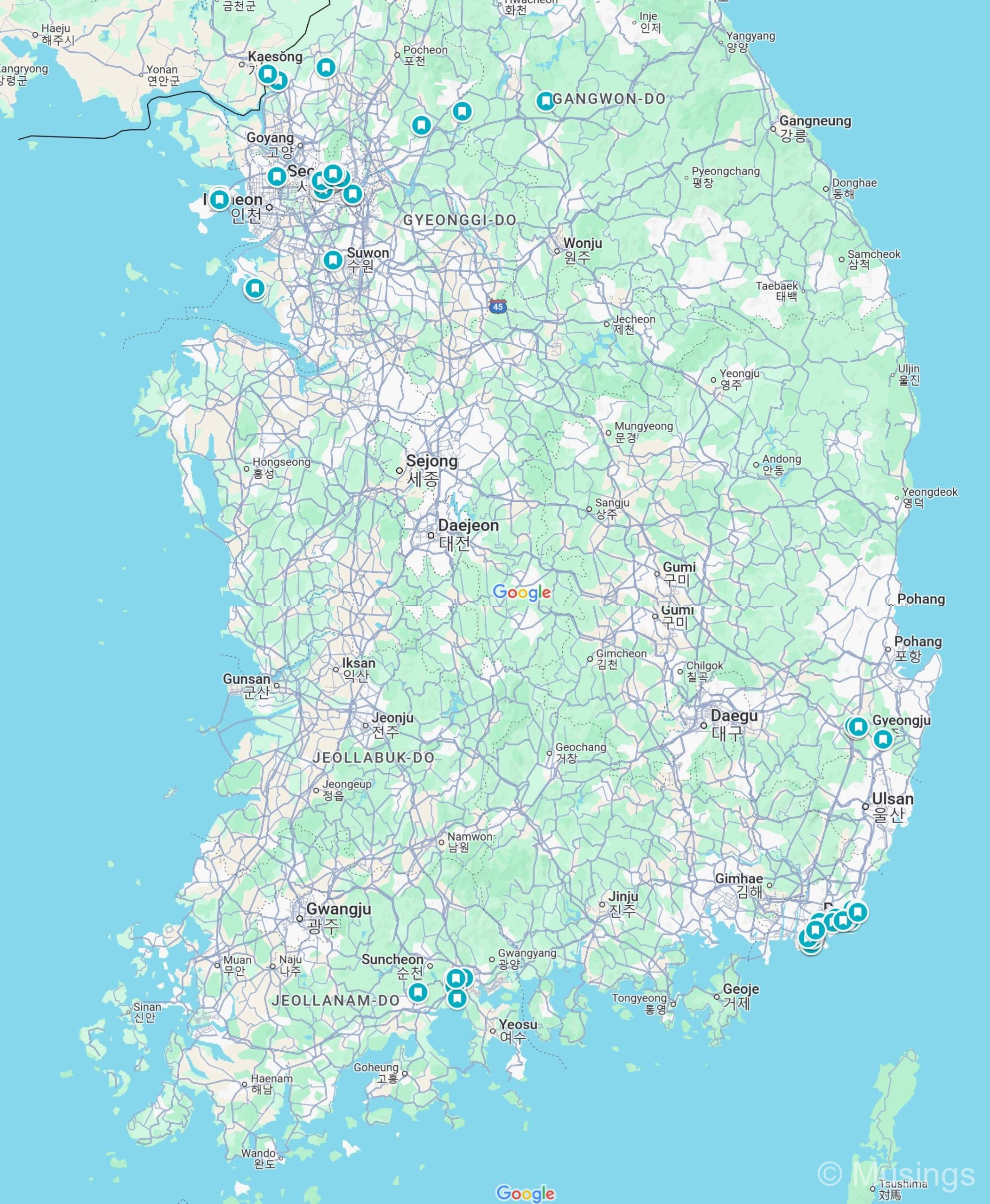
The total cost of this trip was about SGD12K – much less than the around SGD15,500 we spent for our Chubu-Kanto Japan trip last December. And this was largely on account of the cheaper air fare, and also accommodation costs. Dining costs were about the same as Japan’s, and this I again suspect is because of the general absence of cheap nutritional street food that isn’t of the snack food type. Economical rice-veg is really something we Singaporeans take for granted – we really should make that dish a national treasure!
In all, we really enjoyed this trip. Looking forward: 2025 is when both our kids will be taking their national exams, so we’ve already decided to not do significant travel in June. At most, we’d just do a short trip to a nearby country; probably Malaysia. So, we have just one major vacation to plan for in 2025, and it’d be for our year end trip again. More notes to come then in the coming months!